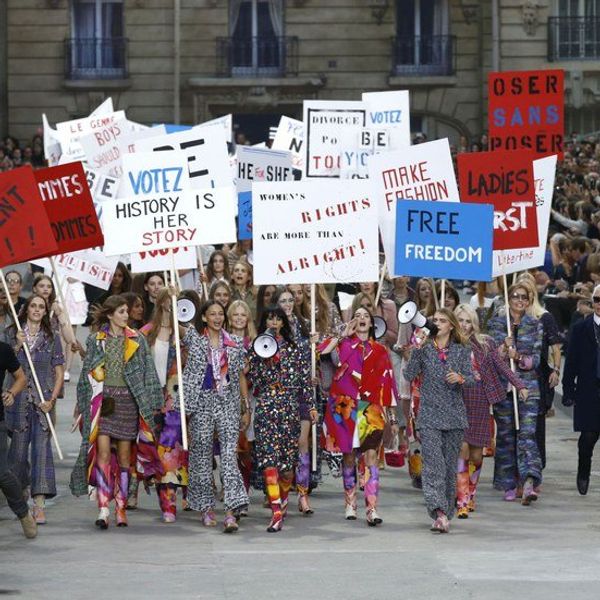Though the idea has come under much scrutiny, the feminist movement in America has been categorized under three titles, or waves: First Wave Feminism, Second Wave Feminism and the modern Third Wave Feminism. The first wave, beginning in 1848 and ending in 1920, is recognized as a version of the movement that focused heavily on the political empowerment of women, women’s suffrage being the most popular of the achievements.
The second wave, existing roughly between 1960 and 1970, turned its attention toward the social roles of women, attempting to shatter the social confines that expected them to become submissive housewives restrained to their homes.
The third wave is described as focusing little on any type of political agenda, but putting effort toward breaking the boundaries and conceptions of gender and also being heavily inclusive of men. Third Wave Feminism has been met with much criticism and scholars cannot decide on a definition, though Merriam-Webster defines the entire movement, feminism, as “the theory of the political, economic, and social equality of the sexes.” Though the first and second waves may have certain similarities (their intense focus on social issues), the differences in precisely what they choose to focus on as well as the means through which they choose to fight are enough to justify the distinction of third wave feminism.
Scrutiny befalls more than just the idea of categorizing modern feminism under its own wave. It extends even to the analogy of waves. It is claimed that to categorize whole portions of the feminist movement under waves serves primarily to oversimplify the complexities and fluid, ongoing nature of feminism. This is true to an extent, as the first wave of feminism is renowned as a movement focused on women’s suffrage and often criticized for its lack of concern for minorities, “equal rights for women, educational and legal reform, abolition of slavery, and ‘suffrage’” were all included in the beginning of the movement.
Proponents of the analogy argue that it “manages to capture the similarities, differences, continuities, discontinuities, and evolution of feminism as a transformation series of movements, epistemology, and activism." As described, the first two waves seem to encapsulate the three ideas specified in the Merriam-Webster dictionary, being political, economic, and social equality. The third wave is extremely similar to the second in that it focuses on social change, but has integral differences that set it apart from the second wave, some being its inclusion of men and its focus on gender and gender roles rather than exclusively dealing with the subjugation of women. The misunderstanding of the beginning of the feminist movement in all that it stood and fought for should be attributed more to the poor execution in educating students on it than the given titles.
One triumph met during the proposed duration of second wave feminism was the Equal Pay Act. An in-depth analysis reveals that the second wave of feminism is characterized strongly by struggles pertaining to “laws surrounding spousal rape, cultural challenges with the treatment and portrayal of women, reproductive rights, and the same de facto inequalities faced by racial minorities." Widely agreed upon, the second wave of feminism in America ended in the early 1980s, following the ratification deadline for the Equal Rights Amendment which earned equal rights for women. This was the first wave to “address the role of women in the workplace, the fight for equal pay, and the need for women to have equal access to leadership roles as men do." The major triumph met under this wave of the movement was the Equal Rights Amendment, which essentially marked the end of the movement as women’s suffrage; their right to vote marked the ending of the first wave.
There were about four decades following where the feminism movement was not a loud and impactful force until this second wave began. Ending in the 1980s, there is much less time between the second and third wave, and that, by no means, justifies ignoring their differences.
One major criticism of the second wave of feminism, one that has been corrected by this third wave, was its “largely heterosexual, middle-class and white focus." With not being very inclusive of other voices and issues, the movement was also exploitative. It “treated the concerns of Black women and lesbians as divisive to the movement instead of an important rallying point."
A term often associated with the third wave of feminism is intersectionality. Coined in 1989, the term is defined by The Oxford English Dictionary as the interconnected nature of social categorizations such as race, class, and gender as they apply to a given individual or group, regarded as creating overlapping and interdependent systems of discrimination or disadvantage. This term is central to this third wave of feminism because, now, feminism focuses seriously on the struggles of all people in society in the realm of gender.
Originally, “third wave characterized a feminism mediated by the terrains of race and multicultural alliances." This inclusive attitude was “a unique mode of ‘everyday theorizing.’" This version of feminism began with examining "not only the intersections between race, class, culture, and sexuality but also the celebration—and coalition politics—of difference." With the large changes relating to and new ideas adopted by third wave feminism, there were women who were alive throughout the second wave of feminism who identify under the title of third wave feminists.
Along with the intersectionality of modern, third wave feminism is the challenging of gender constructs. Referred to as “queer theory,” third wave feminism argues that sexuality is fluid and challenges the notion of heterosexuality as the norm. Feminism has somewhat shifted into the realm of sociology, no longer fighting for equal pay and right, but rather for women to be able to take control of their bodies and their identities, shedding light on the poor and often detrimental way women are socialized growing up in society. A popular and widely misinterpreted statistic that women get paid 77 cents to the male dollar is an example. With the Equal Pay Act of 1963, this would be illegal and unable to continue. This statistic exists because there are not many women entering the S.T.E.M. fields. Third wave feminism asks why and delves into how women are socialized in school and other places, how they are taught they should handle their education and the heights to which they should pursue it.
Third Wave Feminism, like the original two waves, is not without its own criticisms and misrepresentations. Because of what was essentially a smear campaign waged against feminism by government, corporations and primarily conservative white women, the feminist movement has come under much scrutiny and essentially lost its identity for a period of time. The government promoted the message that feminism was no longer needed because women were equal in the eyes of the law while corporations that dealt with beauty, alongside women who opposed feminism, made feminists out to be bitter, unattractive and unintelligent women who were not concerned with real discourse. This caused a rift even within the movement, pushing many women away from wanting to identify under the term “third wave." Even if the descriptions are accurate, feminism should not be judged on the actions or ideas of every individual who purports to operate under its banner.
Third Wave Feminism has been met with nearly everything that made the earlier waves distinguishable other than actual legal change. There is a sect that works on the legal side to make men and women more equal in courts, but, for the most part, the largest hurdles have been overcome. Third Wave Feminism, like Second Wave Feminism, is a continuation of the overall movement, but deserves to be separate and distinct. The third wave has corrected many of the issues of the second wave while taking on a new identity with its intersectionality, focus of sexuality, deconstruction of gender notions, etc. Said to have taken off and adopted the name Third Wave Feminism in the 1990s, modern feminism is in a part of a distinct piece of history and will continue to prove itself unique and useful.





















